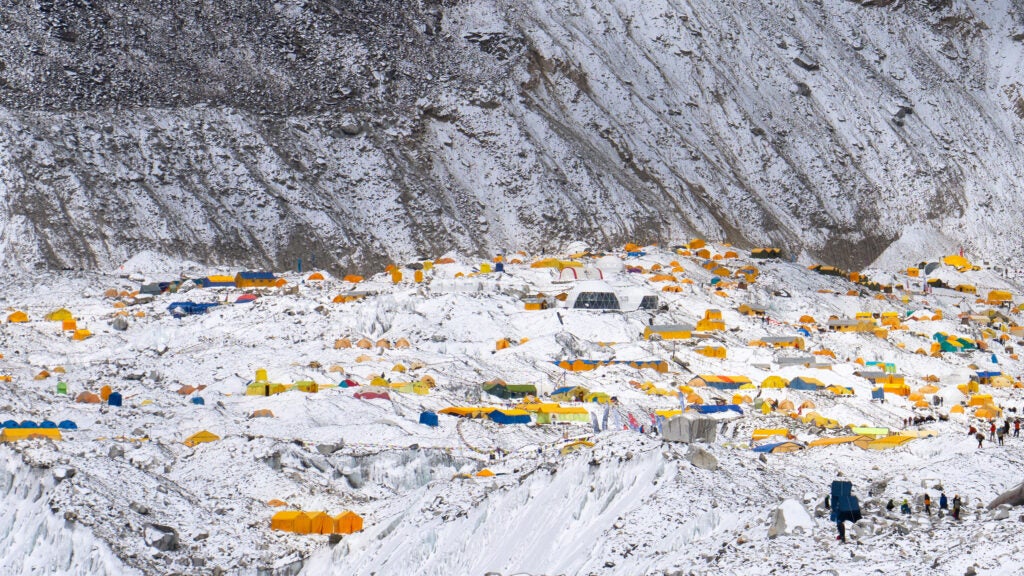No products in the cart.
Outdoor Adventure
The New Rules at Everest Basecamp Make No Sense
It’s been a frustrating month for mountaineering guides who lead expeditions on Mount Everest. The laws governing climbers on the peak’s Nepali side have changed several times, leaving guides confused, anxious, and glued to the Internet awaiting future updates.
“It’s Nepal and nobody knows how the new regulations will be interpreted, implemented, and finally enforced,” said Austrian guide Lukas Furtenbach, the owner of Furtenbach Adventures, who leads Everest expeditions in Nepal.
The situation began on February 8 when the Khumbu Pasang Lhamu Rural Municipality, the governing body that, among other things, oversees the rules and regulations of Nepal’s Everest Base Camp (EBC), said that for 2024 and beyond, climbers would be required to haul their feces off of the peak and down to Base Camp via plastic WAG bags. Then, on February 14, officials with the agency released even more stringent guidelines. These rules regulated the size of square and dome tents, curtailed the use of helicopters to ferry gear to camp, prevented visitors and trekkers from sleeping in camp, and required every climber to carry down at least eight kilograms (17.6 pounds) of garbage from the mountain, among other things.
The document was laden with typos and logical holes, and some of the strict regulations on the size of tents and the helicopter transport left guides scratching their heads. Furtenbach told me that because of the statute’s vague text on tent size limitations, guides would likely just have to bring more, smaller tents. “We might see a Base Camp this year with more tents than ever because of the new regulations,” he said.
But Nepali officials weren’t finished, and February 28, they said that all climbers on Everest would be required to wear a tracking chip. Then, a week later on March 8, the governing body completely revised the rules issued on February 14, and the revisions all-but reneged on some of the rules.
“False alarm. Once again. Nepalese routine,” said Furtenbach.
When we corresponded on February 29, Furtenbach told me that Nepali officials hadn’t reached out to him or other Western operators about the new regulations—like everyone else, he had read about them online. There were several regulations that Furtenbach said did not pass his sniff test.
Among these initial strictures was a rule that forbade the use of helicopters to ferry gear to and from EBC. Instead, all tents, climbing gear, and personnel would need to be transported solely by yaks. The rule’s intention was to not only preserve nature and reduce helicopter traffic in the region, but to bolster the fading cultural practice and industry of yak herding. But Furtenbach told me that there simply aren’t enough yaks in the region to handle all of the gear.
“If this regulation is not relaxed, we will see chaos—teams not getting gear, food, and oxygen to the mountain in time,” he said. The timing of the announcement, just six weeks before the season begins, represented a major curveball for Furtenbach and other operators.
Luckily for them, the revised ruleset gives some leeway to chopper access. After the latest revision, some operators will be able to carry some logistical equipment to and from Base Camp via helicopter, but the process will be subject to a monitoring committee’s approval. However, according to the Himalayan Times, the municipality emphasized that yaks and local porters “should still be utilized for transporting climbing gear under normal circumstances.”
Regulations on tents became another point of contention when the municipality originally outlawed dining tents larger than ten square feet per person. Guides complained that this regulation essentially outlawed the tents used for mealtime and meetings. “This is an error and not practical—it barely accommodates one chair,” Dawa Steven Sherpa, a conservationist and the CEO of Asian Trekking told ExplorersWeb. This restriction has now been eased to 60 square feet for the dining tents and 80 square per person feet for sleeping quarters. While the regulations on dome tents were meant to curb luxury at EBC, the effect was negligible on big operators. “With those calculations in mind, you can use a large dome tent when you have enough members in your team,” said Furtenbach.
A no-visitor policy that would have required medical staff to purchase a separate climbing permit was also eased for guiding operations, but will remain in place for trekkers and general EBC visitors. Friends and family of climbers will now also be allowed to stay at Base Camp.
Another point of confusion was the widely-covered implementation of “tracking chips,” which, in fact, are nothing more than Recco reflectors. These reflectors are often used in avalanche incidents for body recovery, as they require a bulky detector that is often carried via helicopter. “Ground-based Recco searches are not often possible, and on Everest most rescue and recovery missions are above 7,000 meters (23,000 feet), where helicopters never fly,” said Furtenbach.
Furtenbach said his company has tested all manner of sensors, trackers, and even vital-sign monitors on Everest and says each one comes with its limitations, but none so much as Recco. Most climbers on Everest who get lost do so on the summit ridge, far beyond the possibility of a Recco-guided recovery. “A better solution to the problem of climbers getting lost on the mountain would be that their guides do not leave them alone,” he says.
These new rules aren’t coming out of a vacuum. Last year tied the deadliest year on record on the world’s highest peak. “The new [Recco] rule is in response to rising casualties on Everest,” Rakesh Gurung, director at the Department of Tourism told the Kathmandu Post. The Khumbu Glacier, on which EBC sits is melting rapidly. Clearly something has got to give. But with Everest season just a few weeks away, and these rules far from being set in stone, I don’t envy operators trying to suss out planning a group expedition.
Source link

